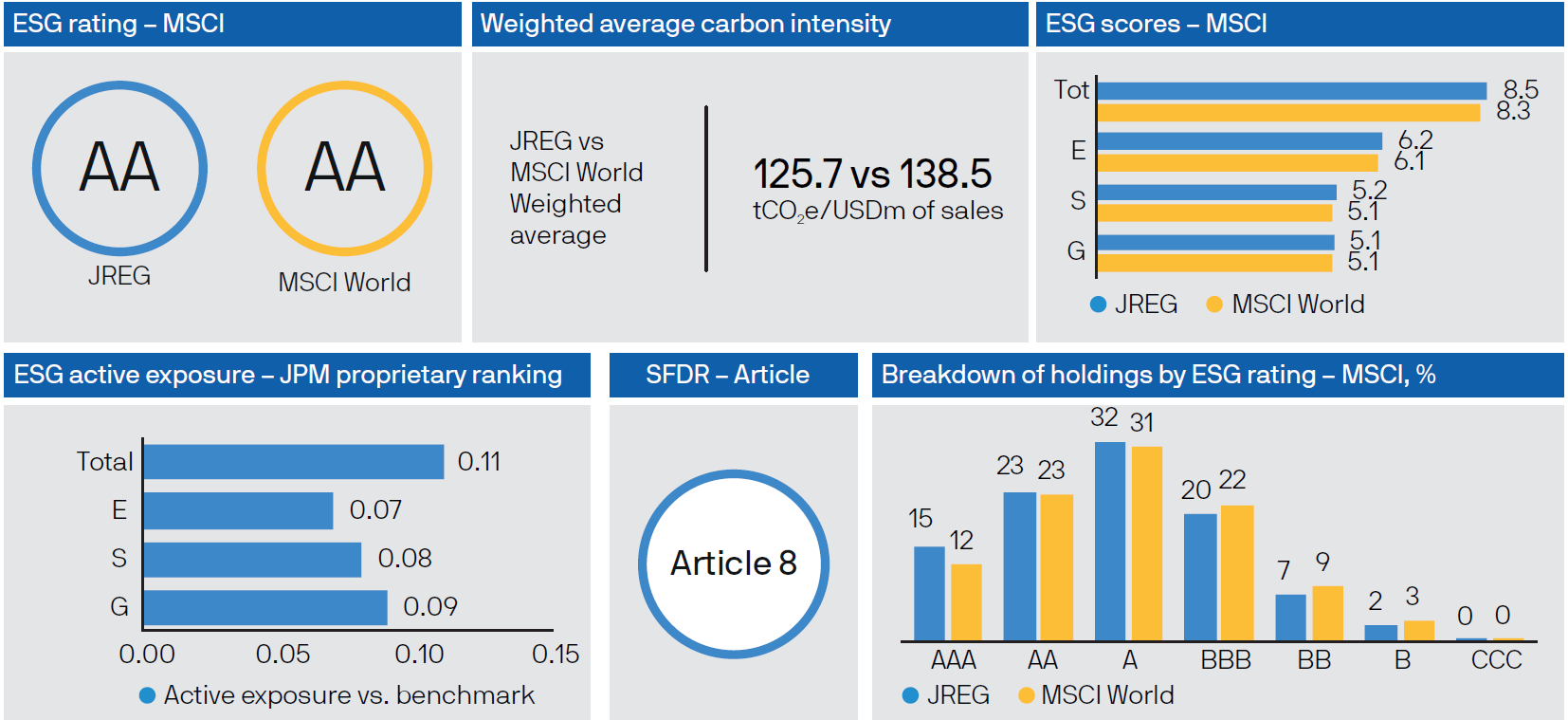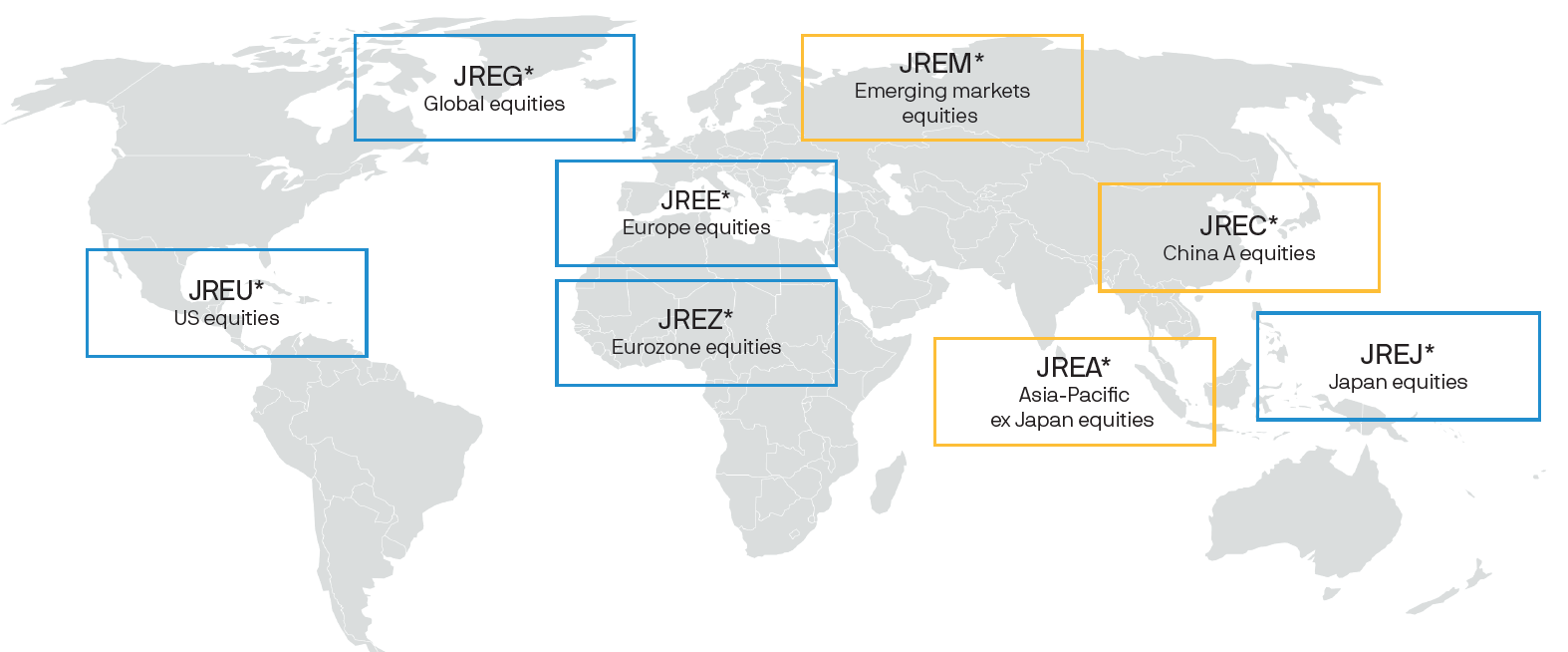Can you please briefly explain what research enhanced indexing is?
While the name might sound complicated, the concept is actually quite simple. Research enhanced indexing (REI) means that you combine the best qualities of passive – index-like regional, sector and style exposures – with active management. We achieve the “enhancement” by applying the insights of our global team of 90+ research analysts. This is a process we have successfully used for over 30 years.
What is new, however, is the transfer of our REI strategies into the ETF wrapper, with our first REI ETF strategy launched in October 2018. The JPM research enhanced index equity (ESG) ETFs* are core building blocks that offer an attractive alternative to passive exposures thanks to their potential to outperform the index – something that we have achieved since we launched the first research enhanced index equity ETFs nearly four years ago.
The alpha component makes REI different from traditional passive ETFs. How do you generate alpha?
What we do is simple but very powerful. Our objective is to translate our stock-specific insights into our REI portfolios while keeping the structure of the portfolios index-like. We do so by combining best in class fundamental research with robust risk management. We have a large team of career analysts who carry out in-depth research on over 2,500 stocks, utilising a disciplined valuation framework, which is used across the whole firm.
These insights are then packaged into an index-like portfolio, by applying small overweight or underweight position in certain stocks. The end result is a style-neutral, sector-neutral and regionally neutral ETF portfolio, which has the same shape and feel as the index and is very diversified at the same time.
How do you incorporate ESG considerations into the portfolios?
ESG has been part of the DNA of this strategy for decades. Our research analysts ask ESG-related questions when they meet company management and assess ESG factors inside and out. When we launched our REI ETFs we recognised the importance of building an ESG profile within the portfolio construction, and have therefore looked to focus our research on three key elements.
First is exclusions, where we look to reduce the investable universe by not investing in common controversial sectors.
Second is ESG integration, which comes from our fundamental research team, who assess companies based on 40 ESG-related questions before incorporating their findings into our long-term earnings forecasts.
The final element is engagement with the companies that we invest in, which provides the opportunity to sit at the table with company management to discuss ESG issues while retaining the ability to divest – in part or in full – if no improvement is made.
I really think this active investment stewardship approach can give us an edge over passive strategies. The combination of these three steps means that all our REI ETFs are categorised as Article 8 under the SFDR classification.
ESG summary: JPM global research enhanced index (ESG) UCITS ETF (JREG)*

Source: J.P. Morgan Asset Management, MSCI,. Benchmark is MSCI World as of 31 March 2022.
Since the JPM research enhanced index equity (ESG) ETFs* are UCITS ETFs, their portfolios are fully disclosed. Can you give us an ESG example from the portfolio that brings the process to life?
A particularly exciting example is John Deere, a stock that is overweight in our Global REI portfolio. John Deere builds farming equipment but has managed to revolutionise its approach by utilising digital tools and machine learning to improve the way farmers work.
The use of artificial intelligence has helped to decrease the amount of herbicides used for farming by 90%, which has had a real positive impact on the environment. But as I said, it is important to understand that John Deere is just one of a large number of active positions in our portfolios. We do not build large overweight positions in single stocks in order to maintain the index-like profile.
How can these ETFs be used in portfolios?
We find that most investors use the REI ETFs as a replacement for their passive core. They are attracted by the index-like exposure, and the opportunity to outperform an index and enhance performance. The REI ETFs also appeal to investors looking for a broadly diversified ETF portfolio, which can provide exposure to a market cap standard benchmark but apply a robust ESG framework at the same time.
Therefore, the JPM research enhanced index equity (ESG) ETFs* have received strong investor interest. The range is now the largest active UCITS equity ETF range. In terms of exposure, some investors have just added one of the ETFs to their portfolio, while other clients – after seeing how the REI strategy can successfully deliver alpha – have broadened their allocation to more than one of the REI ETFs.
Research enhanced index (ESG) ETF range*: Combining active investing with benefits of ETF vehicle in all major markets

You manage REI ETF strategies covering global equities, the US, Europe and the eurozone, as well as Japanese equities. If an investor would like to allocate to just one region to see how the strategy works in their portfolio, which region would you allocate to in the current market environment?
This is like asking which of your children is your favourite! All of the REI ETFs can play a role to enhance the passive core of a broadly diversified portfolio. But if you really look at the market today, I would probably choose exposure to Europe or the eurozone. We think European corporate profits could be better than feared and still expect modest profits growth for European companies this year.
First, European consumers look well positioned to weather the storm, with an estimated $1trn in additional savings accumulated during the COVID-19 lockdowns. Second, as the pandemic fades, European economies will enjoy the benefits of reopening this year. And finally, the companies represented in European stock market indices are globally diversified, with only 40% or so of their revenues sourced from Europe itself. With valuations below long-term averages, European or eurozone equities may still offer a positive surprise this year.
Enhance your core: Developed markets

Next stepsYou can find out more about our REI Equity (ESG) ETFs* here:Austria: am.jpmorgan.com/at/etfBelgium am.jpmorgan.com/be/etfDenmark: am.jpmorgan.com/dk/etfSpain: am.jpmorgan.com/es/etfFinland: am.jpmorgan.com/fi/etfFrance: am.jpmorgan.com/fr/etfItaly: am.jpmorgan.com/it/etfLuxembourg: am.jpmorgan.com/lu/etfNetherlands: am.jpmorgan.com/nl/etfNorway: am.jpmorgan.com/no/etfPortugal: am.jpmorgan.com/pt/etfSweden: am.jpmorgan.com/se/etfSwitzerland: am.jpmorgan.com/de/etfUnited Kingdom: am.jpmorgan.com/uk/etf
*FOR BELGIUM ONLY: Please note the acc share class of the ETF marked with an asterisk (*) in this document are not registered in Belgium and can only be accessible for professional clients. Please contact your J.P. Morgan Asset Management representative for further information. The offering of Shares has not been and will not be notified to the Belgian Financial Services and Markets Authority (Autoriteit voor Financiële Diensten en Markten/ Autorité des Services et Marchés Financiers) nor has this document been, nor will it be, approved by the Financial Services and Markets Authority. This document may be distributed in Belgium only to such investors for their personal use and exclusively for the purposes of this offering of Shares. Accordingly, this document may not be used for any other purpose nor passed on to any other investor in Belgium.*FOR FRANCE ONLY: Investors should note that, relative to the expectations of the Autorité des Marchés Financiers, JPMorgan Research Enhanced ESG ETF suite presents disproportionate communication on the consideration of non-financial criteria in its investment policy (Cette presentation convient aux investisseurs parlant couramment anglais).
This is a marketing communication and as such the views contained herein do not form part of an offer, nor are they to be taken as advice or a recommendation, to buy or sell any investment or interest thereto. Reliance upon information in this material is at the sole discretion of the reader. Any research in this document has been obtained and may have been acted upon by J.P. Morgan Asset Management for its own purpose. The results of such research are being made available as additional information and do not necessarily reflect the views of J.P. Morgan Asset Management. Any forecasts, figures, opinions, statements of financial market trends or investment techniques and strategies expressed are, unless otherwise stated, J.P. Morgan Asset Management’s own at the date of this document. They are considered to be reliable at the time of writing, may not necessarily beall-inclusive and are not guaranteed as to accuracy. They may be subject to change without reference or notification to you. It should be noted that the value of investments and the income from them may fluctuate in accordance with market conditions and taxation agreements and investors may not get back the full amount invested. Changes in exchange rates may have an adverse effect on the value, price or income of the products or underlying overseas investments. Past performance and yield are not a reliable indicator of current and future results. There is no guarantee that any forecast made will come to pass. Furthermore, whilst it is the intention to achieve the investment objective of the investment products, there can be no assurance that those objectives will be met. J.P. Morgan Asset Management is the brand name for the asset management business of JPMorgan Chase & Co. and its affiliates worldwide. To the extent permitted by applicable law, we may record telephone calls and monitor electronic communications to comply with our legal and regulatory obligations and internal policies. Personal data will be collected, stored and processed by J.P. Morgan Asset Management in accordance with our EMEA Privacy Policy www.jpmorgan.com/emea-privacy-policy. As the product may not be authorised or its offering may be restricted in your jurisdiction, it is the responsibility of every reader to satisfy himself as to the full observance of the laws and regulations of the relevant jurisdiction. Prior to any application investors are advised to take all necessary legal, regulatory and tax advice on the consequences of an investment in the products. Shares or other interests may not be offered to or purchased directly or indirectly by US persons. All transactions should be based on the latest available Prospectus, the Key Investor Information Document (KIID) and any applicable local offering document. These documents together with the annual report, semi-annual report, instrument of incorporation and sustainability-related disclosures, are available free of charge in English from JPMorgan Asset Management (Europe) S.à r.l., 6 route de Trèves, L-2633 Senningerberg, Grand Duchy of Luxembourg, your financial adviser or your J.P. Morgan Asset Management regional contact or at www.jpmorganassetmanagement.ie. A summary of investor rights is available in English at https://am.jpmorgan.com/lu/investor-rights. J.P. Morgan Asset Management may decide to terminate the arrangements made for the marketing of its collective investment undertakings. Units in Undertakings for Collective Investment in Transferable Securities (“UCITS”) Exchange Traded Funds (“ETF”) purchased on the secondary market cannot usually be sold directly back to UCITS ETF. Investors must buy and sell units on a secondary market with the assistance of an intermediary (e.g. a stockbroker) and may incur fees for doing so. In addition, investors may pay more than the current net asset value when buying units and may receive less than the current net asset value when selling them. In Switzerland, JPMorgan Asset Management (Switzerland) LLC, Dreikönigstrasse 37, 8002 Zurich, acts as Swiss representative of the funds and J.P. Morgan (Suisse) SA, 8 Rue de la Confédération, 1204 Geneva as paying agent of the funds. JPMorgan Asset Management (Switzerland) LLC herewith informs investors that with respect to its distribution activities in and from Switzerland it receives remuneration which is paid out of the management fee as defined in the respective fund documentation. Further information regarding this remuneration, including its calculation method, may be obtained upon written request from JPMorgan Asset Management (Switzerland) LLC. This communication is issued in Europe (excluding UK) by JPMorgan Asset Management (Europe) S.à r.l., 6 route de Trèves, L-2633 Senningerberg, Grand Duchy of Luxembourg, R.C.S. Luxembourg B27900, corporate capital EUR 10.000.000. This communication is issued in the UK by JPMorgan Asset Management (UK) Limited, which is authorised and regulated by the Financial Conduct Authority. Registered in England No. 01161446. Registered address: 25 Bank Street, Canary Wharf, London E14 5JP.LV–JPM53789 | 07/22 | 091x220807142637



